Name of Nation: Empire of the Four Species
Species: Abh
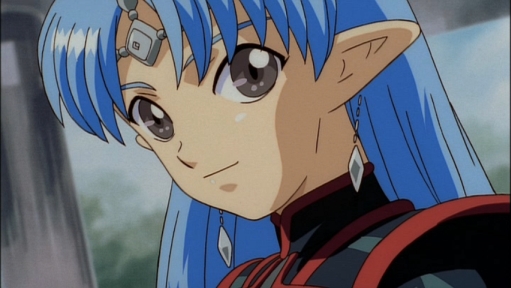
Abh breath an oxygen atmosphere, though their tolerance for lower concentrations is much higher than that of a human's. They also have much fewer toxic gases. Interestingly, a Abh can drink and eat everything humans do, although they have a cultural preference towards water and wine when drinking. Their food is very much reminiscent of what we would consider Asian today. This is a species-wide phenomenon, implying a very early point of "unification". Their language is known as "Sānshingenō".
One of the major oddities of the Abh is their natural ability to interface with computer systems, an ability that has been used since the very first digital computers. They were found to be capable of interfacing with the computers found in ancient ruins as well, which have the same basic structure as Abh computer systems. Attempts have been made at interfacing with the computers of the hostile alien race, but no success has been found, with the subject's brain rejecting the computers. This ability to interface with ancient computers is completely unexplained, but is widely believed to be a simple fluke of nature. There are those who believe that it was intentional modification, but there is no experimental proof of this, with no markers in Abh DNA showing any sign of genetic tampering.
Due to the high gravity of their homeworld, the Abh are stronger and more resilient than most species. However, you wouldn't expect it. They look just as frail as humans before they start throwing punches, thanks to their astoundingly dense muscles. In fact, their muscles are so dense that the idea of them evolving naturally is practically absurd. In a hand-to-hand fight, Abh will usually win. However, at rage, they're just as vulnerable as anyone else.
A major oddity with the Abh is that, although they do not know it, they are genetically compatible with the Romus Humans. Since the odds against such a thing occurring separately are astronomical, it is extremely likely that the Abh and Romus Humans are related. However, the Romus are from Earth, an entire galaxy away. If these facts were to be discovered, it would likely cause a great debate on the relation between the two species.
Homeworld: Shōrino'ba, sixth planet of the Tsutā System.
Description of Government: Feudal Empire, headed by an Emperor.
Description of Military: The Abh Military is split up into four branches: The Imperial Spaceborne Navy (ISN), the Imperial Airborne Defense Forces (IADF), the Imperial Oceangoing Defense Navy (IODN), and the Imperial Planetbound Defense Army (IPDA).
Imperial Spaceborn Navy Craft:

-Doraic-Class, a vessel built to transport ground and air forces, this class is also equipped with extensive scanning and electronic warfare equipment. It was named for Doraic Ssynec Ymer Spainaic, the lead scientist in the first Sūkaiisutshō Expedition. It is equipped mainly with plasma launcher weapons for defense, which makes it excellent for point defense. There are multiple variations, one of which (the Doraic-B) carries Semurr-Class spaceborne fighter-bombers.
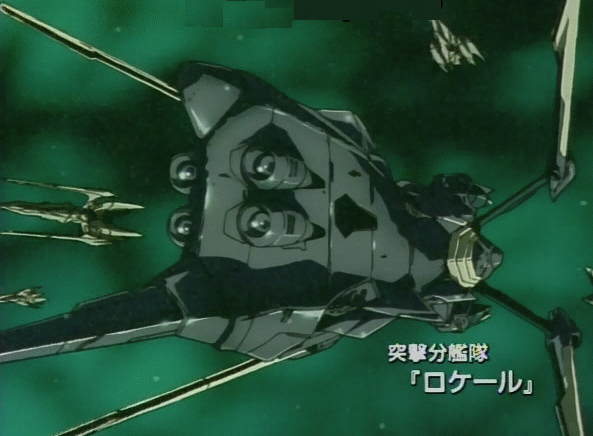
-Kaguya-Class Bombardment Vessel, a starship class designed for long-range bombardment of enemy forces and planets. Though it's primary use is bombardment, it is often seen taking point in a close-range battle due to it's extensive missile capabilities. The four large prongs are railguns, which can fire either dumb tungsten slugs, dumb bombs, or guided missiles. It is named for a myth believed to be more ancient than the Abh themselves.
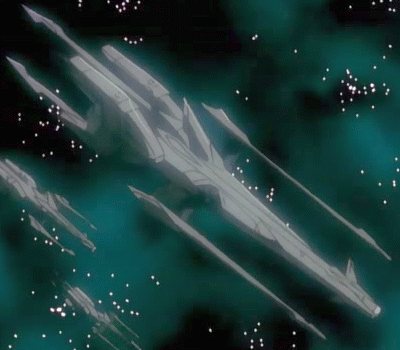
-Ryouta-Class Battleship, one of the more common vessels on the battlefield. As one might expect, this class is built for the sole purpose of causing as much damage to the enemy as possible. It has two railguns, which are fully capable of providing bombardment support, but it truly shines in the middle of battle. Hidden within it's hull are multiple antiproton streamers (weapons which fire streams of antiprotons), which are extremely effective at close to middle ranges, though they are most certainly non-trivial even at long ranges. They are especially good at shredding though enemy armor. This class is also named for a prehistoric myth.
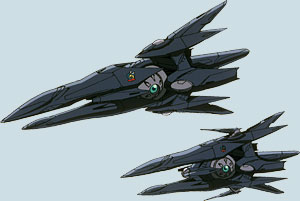
-Guyoka-Class Destroyer, a ship class deployed in large numbers and used to swarm the enemy. They are armed with four plasma launchers as point defense (though they are effective as ship-to-ship weapons as well). Their main armament is their spinal antiproton weapon, which fires pulses of antiprotons straight forward. This weapon, combined with their maneuverability, makes them extremely formidable against larger ships in groups (especially if said larger ship has little point defense). They are named for a somewhat large insect found on Shōrino'ba, which have been known to kill adult Abh in swarms when provoked.

-Teikkupuraim-Class Battlecruiser, a ship class built for all possible space combat situations. This class carries a small complement of Īguru-Class spaceborne fighter-bombers, but that is far from it's only defense. It also carries extensive missile systems, which are utilized alongside antiproton streamers and plasma launchers. When combined with the extensive electronic warfare and communications suites, this ship is by far the most formidable in space combat. For planetary sieges, it has a single, dual-mode spinal weapon that can act as a railgun or antiproton streamer. As it is the largest class in the entire navy, it is usually seen operating as a command vessel, often personalized by it's commander. It's name, when roughly translated, means "Honor of the Empire".
Imperial Airborne Defense Forces Craft:
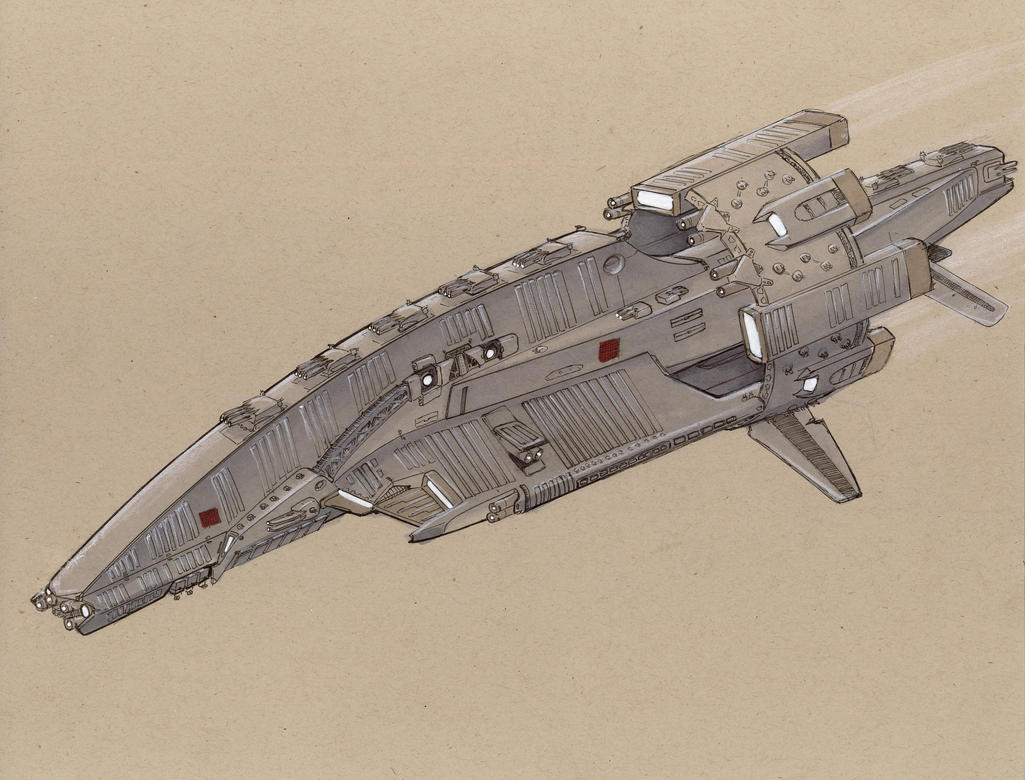
-Kyōrkaizei-Class Aerial Battleship, utilizing antigravity technology, this design is utilized in the atmosphere of planets to combat aerial carriers and other battleships. The circular engine pod holds turboprop engines, but they can be replaced with rocket and plasma engines for spaceborne operation (as is seen here). These ships can also be called in to provide air support, and can even be modified for orbital patrols as mentioned above. However, all are operated by the Imperial Airborne Defense Force. Name means "Great Wind" in Sānshingenō.
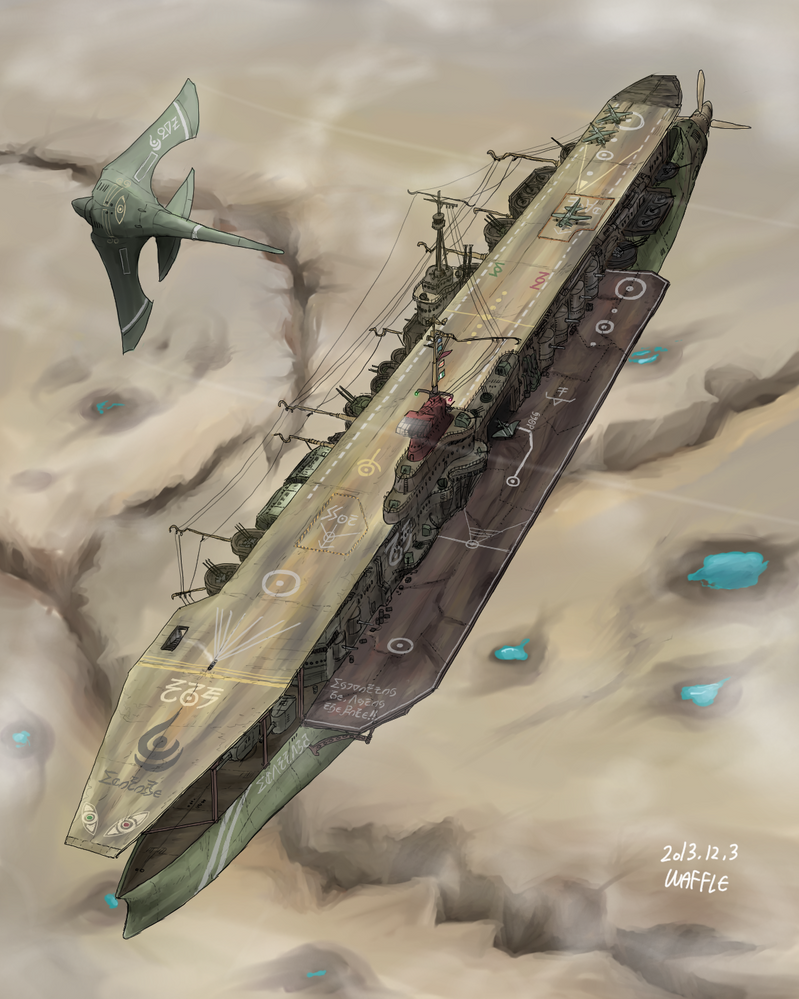
-Kujiryū-Class Aerial Carrier, named for a mythical dragon-like creature, this class of ship is a traditional design taken from the seagoing carriers. It utilizes a turboprop engine for increased endurance, as it is in the air for extreme periods of time. It carries multiple Haisana-Class Aerial fighter/bombers (seen in the top left), which use turbofan engines as they are stationed on the carrier and thus do not require the extra endurance.
IODN Craft:

-Iruka-Class Carrier, this class of ship has the exact same purpose as the Kujiryū-Class Aerial Carrier, and carries the same Haisana-Class Aerial fighter/bombers as it does. The design has been in use for well over a century, every time a new breakthrough it made, it is simply incorporated into the design. As one might suspect, it inspired the design of the Kujiryū-Class Aerial Carrier. It's design is ingrained in Abh culture, with a common joke about the lack of a dedicated spaceborne carrier blames the prevalence of this design, as it would be ineffective in space. The name references a mythical sea Goddess that is said to have sacrificed themselves to save the Abh, and the reverence shown to them in Abh religion is likely the cause for the continued use of this design.

-Teikokunken-Class Dreadnought, this class is extremely rare, with only a handful in use. They are built to be the ultimate in sea combat, armed with multiple railgun turrets, anti-air defenses, and missile tubes, these ships can take on a small enemy fleet without any backup. They also carry a light complement of Haisana-Class Aerial fighter/bombers, launched from electromagnetic catapults at the aft. Unlike most ships (which are powered by a fusion reactor), Teikokunken-Class Dreadnoughts are powered by the same antimatter reactors used on starships.

-Chikyū-Class Battleship, named for a mythical land, this class has also been used for over a century (likely for the same reason as the Iruka-Class Carrier, as Chikyū is the homeland of multiple mythical deities revered in Abh religion). It is designed purely for ship-to-ship combat, with railgun turrets and missile tubes comprising it's entire armament. However, it does carry two mini-submarines that are used to deliver up to four torpedoes each, an extremely effective strategy.
Imperial Planetbound Defense Army

-Heavy Hovertank, used mainly in vehicular combat, this tank is exceptional at destroying enemy vehicles. It is also useful in attacking enemy infantry, though the previously used tactic of running over the enemy (causing absolutely disgusting scenes that any human would end up with PTSD over) is no longer useful as that ability was sacrificed for increased maneuverability with the advent of antigravity technology. It is armed with two heavy railguns, a complement of ground-to-ground missiles, and a gatling coilgun.
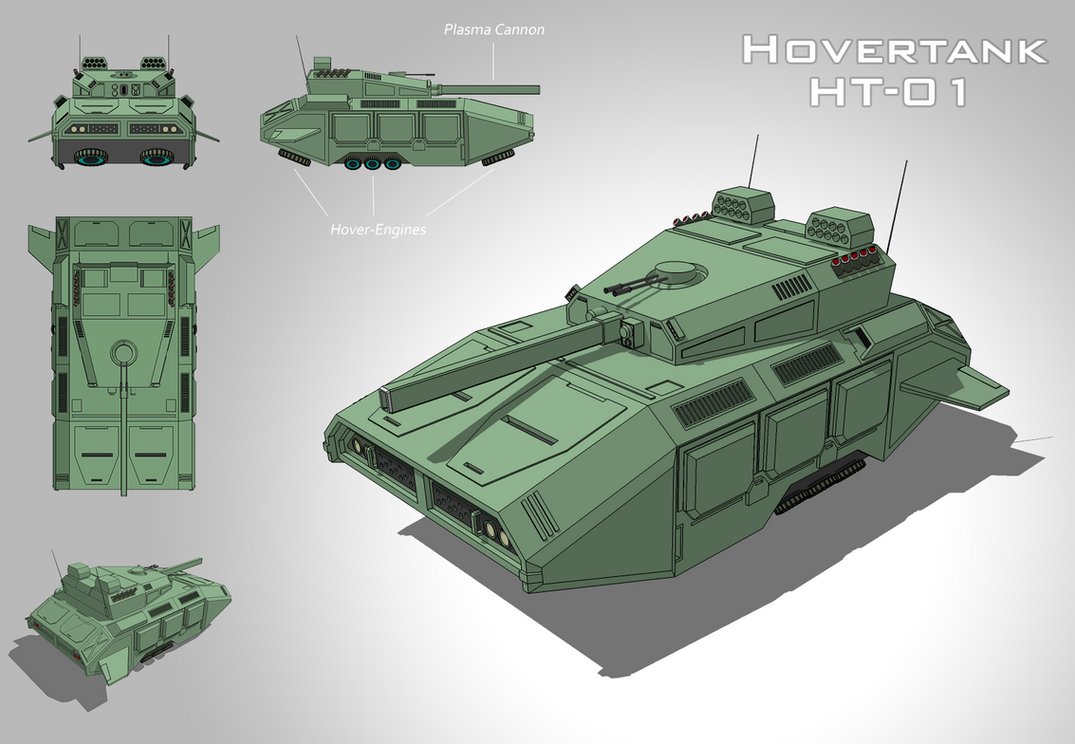
-Light Hovertank, used in a support role, this hovertank is used againt infantry exclusively. It's main barrel, instead of being a railgun like one would expect, is actually a plasma launcher. Since Abh plasma weapons are nigh impossible to focus in-atmosphere, this tank's main barrel acts almost like a flamethrower (albeit a long range, effective against armor one). It also carries a complement to ground-to-ground missiles, as well as a light coilgun.
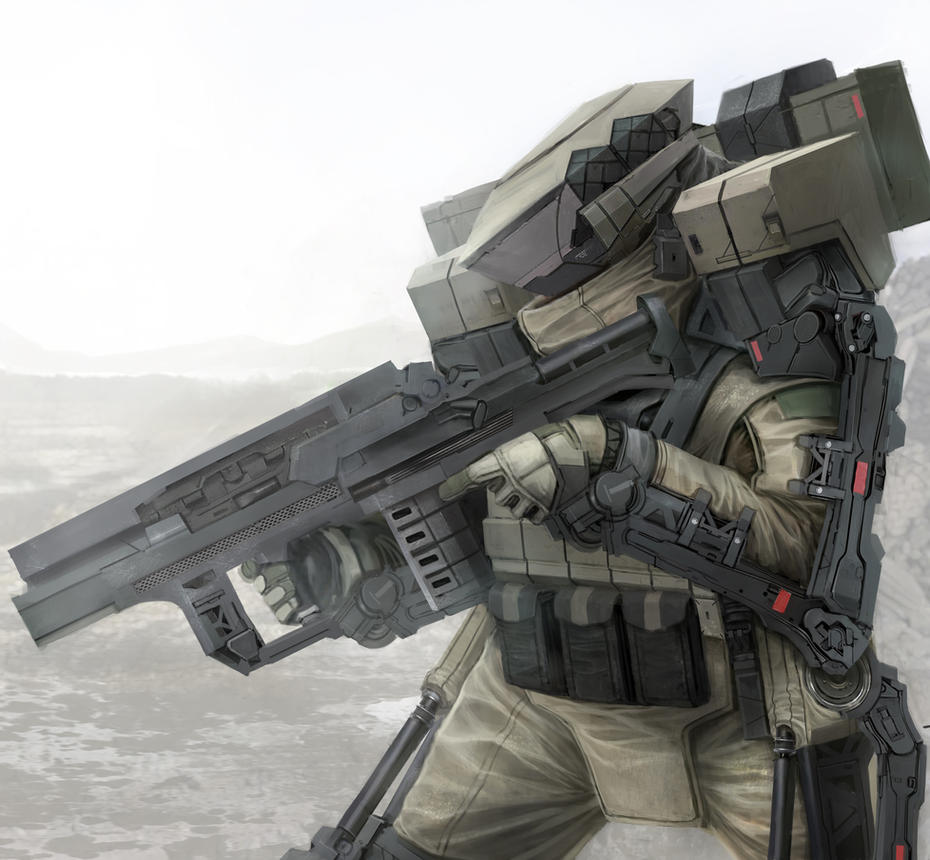
-Semarri Type 1 Combat Exoskeleton, a light combat exoskeleton deployed in offensive and special operations missions, this exoskeleton offers increased mobility, but has less armor than the Type 2. Both utilize the same helmets, which relay battlefield information and protect them from attacks to the head better than standard army helmets (as well as make it harder for the enemy to steal their ears as a trophy, something disturbingly common in internal conflicts).

-Semarri Type 2 Combat Exoskeleton, a light combat exoskeleton deployed mainly in the trenches for defense operations, this exoskeleton offers almost tank-like armor, but at the cost of reduced mobility compared to the Type 1. Both utilize the same helmets, which relay battlefield information and protect them from attacks to the head better than standard army helmets (as well as make it harder for the enemy to steal their ears as a trophy, something disturbingly common in internal conflicts).
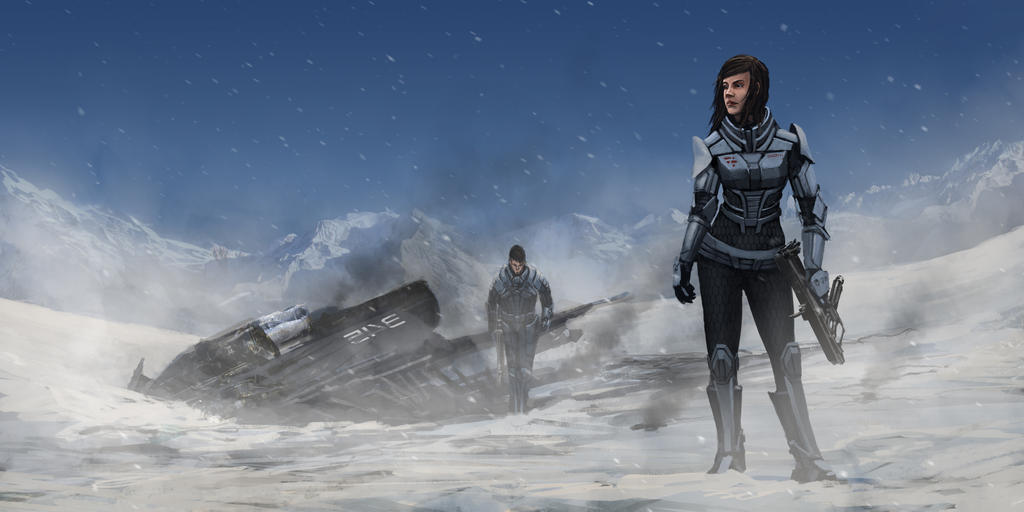
-Infantry Body Armor, the standard armor for Abh Infantry, soldiers wearing this garment are deployed in all types of combat situations.
Abh Uniforms:
IPDA/IADF Uniform:
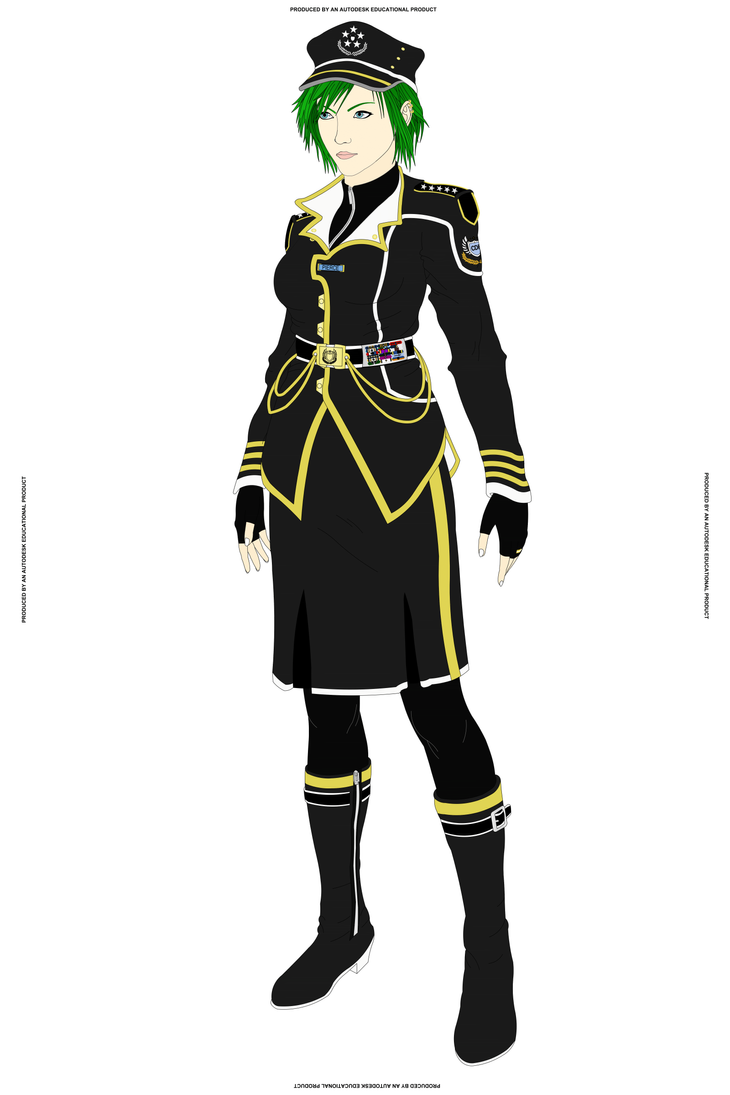
To the Abh, armor and uniforms are entirely separate, and thus this is the only technical uniform in the army and air force. It is used essentially whenever armor is not needed, including formal events. It is used in both the IPDA and IADF as the IADF was originally a subsection of the IPDA, before being split into its own division.
ISN All-Purpose Uniform:

This uniform is used in all situations for the ISN, and is not designed for any sort of functionality. Being used in the ISN, it was never meant to be utilized in personal combat. It is also used in formal events, as the Abh do not have separate formal and informal uniforms. This uniform gets a lot of flak for its color, as it constantly gets dirty when off the ship.
IODN All-purpose uniform:

Like the ISN uniform, this was never meant for personal combat. However, unlike the ISN uniforms, it's harder to get it dirty.
Technological Overview: Abh technology is quite advanced, with antigravity being a staple of everyday life. Military technology includes railguns, coilguns, lasers (rarely used), antimatter weapons, and plasma weapons. However, most of this technology is scavenged from ancient ruins, and the only thing truly Abh about their space force is the designs. The ground forces, meanwhile, are made up much more of Abh technology, mainly due to how plasma and antimatter weapons are either useless or catastrophically effective.
Their space travel technology is limited to the highly advanced Dimensional Jump Drive and the significantly less advanced antimatter/matter annihilation drive. The latter is used by most civilian starships, with them utilizing the Hashichi (Krasnikov Tubes) to travel at FTL speeds. Their warships use shields that grow stronger as they are attacked, with the generators projecting an energy field that converts all incoming fire to energy to power the shield. However, the shortcomings of this system are obvious: too much fire, and the shield system is overloaded, causing damage to other systems as well as making the shield worthless until repairs can be carried out. Thus, the amount of fire a ship can take is directly proportional to how much excess energy the ship can store or dispose of.
As mentioned, antigravity is an integral part of the Abh economy. With it, planetary mining is just as lucrative as asteroid mining, and the transport of cargo and passengers from a planet's surface to orbit and vice-versa is completely free. Landing troops on an enemy world is effortless, with transports requiring no fuel aside from the negative energy reserves they were filled with when built (The negative energy is not disposed of, instead being kept inside of a space-time bubble that keeps it from causing any effect until activated). All ships are equipped with an antigravity system, which allows them to neglect orbital insertion, which is a tactic used to gain the upper hand in maneuverability in battles, as they would not have to worry about their orbit when executing burns. However, such a usage of the device causes any Abh debris to impact the planet below, which is not always a bad thing when you consider that the tactic is mainly used in offensive operations.
Abh propulsion on the battlefield can take two forms: chemical rockets and antimatter/matter annihilation engines. Both are the only sublight engines that are capable of providing enough thrust to be effective, though each has it's merits and shortcomings. Chemical rockets are considered safer, and have easier thrust control, but their fuel supply is extremely limited (if a vessel used only chemical rockets during battle, it would run out of fuel by the end). Antimatter/matter annihilation engines have a higher thrust, and a single tanker filled with anti-substance fuel can keep a fleet supplied with fuel for months. However, if the fuel tanks of a warship are ruptured, the entire vessel will detonate, throwing shrapnel out at speeds that could potentially cause millions of deaths if the ship is in orbit of an inhabited planet. Furthermore, if the tanker were to crash, it would likely cause the destruction of whatever it crashed into, especially a planet with an atmosphere. Luckily for anyone on the field of battle, all ships are equipped with venting systems that eject the anti-substance fuel at a steady and safe rate, forming a cloud that could be passed through with shields up. The use of a tanker as a weapon is, however, not unheard of. Multiple plans for an attack on the alien capital involved crashing a tanker into it, obliterating any possible resistance. However, even the Abh find this too horrific, and it is kept as a last resort only.
Cultural Overview: The Abh operate on a loose Feudal system where families can move up and down in status depending on their actions. Racism ans sexism are unheard of, as all Abh are believed to be the children of the Goddess Abh (However, homosexuality was considered a sin up until around the expedition to the seventh planet, as having a child was considered an incredibly important duty for both the man and the woman). Interestingly, nobles are not guaranteed a high military rank, they have to climb the ranks just like anyone else. Due to this, the Emperor could be a mere captain under the command of an Admiral born into a family of planetary miners. However, strict social rules make it shameful for a noble to refuse military service, as it is seen as a responsibility. Not abiding by this rules has resulted in many a family being removed from the spot of emperor.
The Economy of the Empire is a form of highly-regulated capitalism. While there are still familiar hierarchies and corporations, workers rights are actively protected by the government. There is no national minimum wage, instead, each planet is broken up into economic zones that have their own minimum wages set by the Imperial government. These wages often fluctuate, as they are meant to represent the cost of living in their respective economic areas. If a corporation is found to be violating the minimum wage, then an official investigation is preformed and if the wages being paid are considered inadequate, extreme measures are often taken (More than once has a CEO been killed by the government for violating wage laws).
The Abh value honor more than anything, especially the nobles. A strict honor code exists for everyone, with major influence from Abh mythology. The Noble Honor Code is especially strict, and being a noble is considered more of a responsibility than a privilege. It is believed that if you follow your caste's honor code, then you will be rewarded in your current or next life. A famous legend tells the tale of a Noble who starved to death in order to feed a large group of travelers. His family is said to have become one of the twenty-seven houses with a claim on the throne, with the gods themselves choosing to give it good fortune in respect of his sacrifice.
Another major part of the honor code is honor in battle. If two generals made a deal to use specific tactics in a battle so as to make it fair, and one of them used other tactics to counter the methods agreed upon, it would not give the other general an excuse to break his end of the deal. Even if his entire army was annihilated, stepping down to the level of the enemy general would be considered unforgivably dishonorable. On the other hand, if the general honored in deal despite of the enemy's actions, he would be rewarded for it in his next life. The reward of honorable actions in the next life is obviously a major part of Abh culture, and was formerly used to keep a strict caste system from falling apart. With the advent of individuals becoming mobile in the system, its practical usage disappeared and it simply became another part of Abh culture.
The Abh have always considered melee weapons to be a truer show of strength than ranged weapons. Tournaments of dismounted melee combat have been comment throughout Abh history, and even today every member of the military carries a katana or other melee weapon. Many of the major houses keep ancient weapons preserved through nanorobotic restorations, an extremely expensive process. These weapons are always extremely important to the family, usually being a part of a famous battle or made by a legendary weapon smith.
Abh religion is polytheistic, with there being multiple deities forming a pantheon. There are eight deities, with multiple demigods and mortal servants also factoring in:
-Ethana, Goddess of war
-Iruka, Goddess of the sea and sacrifice (Revered for her sacrifice to save the Abh)
-Boskō, God of knowledge
-Depha, Goddess of luck and community
-Abh, Patron Goddess of the Abh (Believed to have created the Abh with her own body, who then took up her name out of respect)
-Urani, Goddess of Curiosity (Also believed to be the conduit between the Gods and the Mortals, all prayers are directed towards her. She is sometimes called "Zaicdaruta", which translates to "The One Who Watches", as it is believed that she will never interfere with Mortal affairs)
-Ningen, God of perseverance and hope
-Draka, Goddess of Evil, seen as the enemy of all other gods but Urani
Ningen is believed to be the leader of the gods, and is often called the "Kamigamgen", or "God of Gods" when loosely translated. He is believed to be fair and kind to all things, punishing everyone (including himself) equally. However, it is said that in the past he tried to kill Boskō and Ethana, Boskō dozens of times, but Ethana only once. During his fights with Boskō, he is believed to have almost killed Iruka, his sister. He never forgave himself for this, and it is said that even now he will bow in humility and ask for forgiveness when meeting another being, even if that being is a mortal. This legend gave rise to the Abh custom of "Shin-yasai", or "True Kindness". To follow his example, Abh bow to all that they meet in respect of Ningen.
Iruka is revered as much as Ningen, as she is believed to have sacrificed herself to save the Abh. It is said that after her sacrifice, Ningen desperately tried to save her, putting her essence into an iron body that could not rust. Many Abh sailors will swear that they have seen her while at sea, her mechanical body playfully leaping out of the water as if to say hello.
In the legends, Boskō is said to be the older brother of Ningen and Ethana, looking out for them until one day Ningen became fearful of Boskō's far superior intellect and tried to kill him. Boskō took Ethana and fled Chikyū, refusing to harm his beloved brother, but left behind a small part of his essence, hoping it could one day save Ningen. While Boskō hid from his brother in another world, Ningen tried to destroy the essence he left behind in a battle that lasted thousands of years. However, the essence that was left behind was hope, and even as Ningen tried to destroy it, another part of him still fed it. Whenever the essence of his brother was almost gone, Ningen would find that it would suddenly grow larger than ever before. Finally, he tried to destroy it using a device of his own creation (the effects of which bear amazing similarities to atomic weapons, causing them to never be implemented by the Abh). He utterly failed at this, as moments after he tried to destroy it, it grew to it's largest, and something changed in Ningen. He became regretful of his attempts to kill his brother, and accepted the essence into himself, becoming the God of Hope. He found Boskō and Ethana, but at first did not recognize his brother. When he discovered Boskō and Ethana's true identity, a joyful reunion took place as the three became not just siblings, but the best of friends. After his reunion with his siblings, Ningen focused all the energy that was once focused on killing Boskō on battling the evil Goddess, Draka. In his attempts to defeat her, he joined up with Depha, created Abh as a warrior, and elevated Iruka (Formerly a mortal fish) to godhood. Despite being hopelessly weak when compared to Draka, they managed to win the fight against her through Ningen's power of will, which kept them from losing a single battle with Draka.
After this great battle, Abh began to grow in character, becoming more than a mere warrior for Ningen. Ningen, however, refused to give her the right to call herself a Goddess, believing that she was too bloodthirsty to be trusted with such a title. Afraid that she would try to kill him, Ningen gathered the other gods together in an attempt to oppose her. However, the day at which she tried to kill him never came, and she instead continued her protests. Pleased that she refrained from violence, Ningen elevated her to godhood, an action which gained him her completely loyalty. For a time, all was good.
However, this idyllic period of time was not to last. Draka's evil essence lived on, and did what she never could. As essences are far more powerful than the gods that hold them, this evil essence spread over Chikyū trillions of times over, engulfing all in darkness. Abh, hoping to keep the good essences of the gods alive, tore herself apart piece by piece. The pain was horrifying, but she kept doing it, hoping to save her essence. She shaped each and every piece of herself into an Abh, who, out of reverence of her, adopter her name. By the end, the Goddess Abh was gone, but her essence lived on in the Abh species. She sent them to Shōrino'ba, a place that would be safe from all evils. Therefore, all Abh have a tiny part of them that is the Goddess' essence, and every new Abh born strengthens good.
The forces of good are still engaged in an eternal battle with Draka and her forces of evil, and it is believed that all Abh must assist the forces of good in this battle by doing "Good Works" (Helping others, fighting evil mortals, and having children). Because of this belief, those who choose not to have at least one child are frowned upon, though adoption has become increasingly recognized as a replacement for having a child due to it involving raising the child and helping them, thus being viewed as half of the last good work and all of the first. Many believe that the aliens current being fought are not just evil mortals, and that they are the puppets of Draka herself, and even those who don't consider the current war a religious one.
History: The Abh have always been warriors, almost fine-tuned to fighting. On their homeworld, there are eight large continents and multiple surrounding islands. Abh artifacts appear on all of these continents at around the same time, suggesting that they were all connected into one supercontinent at some point. Abh civilization formed relatively quickly, but a disaster of some sort in the ancient past destroyed this young civilization (This is referenced in the Abh religion, and it is said that only because of Iruko's intervention that the Abh survived at all). There was an extremely long dark period after this, with the Abh living as uncivilized hunter-gatherers. Eventually, farming was rediscovered, and the Abh incorporated it in an interesting way. While some groups lived in one area and farmed the land, most Abh tribes continued to live a nomadic lifestyle, instead leaving crops to grow naturally in protected areas. After a certain amount of time, they would return to harvest and plant.
Over time, the Abh slowly began to transition into a stationary lifestyle. A few tribe members began to stay behind at these farms, tending to them like the few tribes that lived entirely off of agriculture. As time went on, the farming areas became villages, and the nomadic tribe members became trader/hunters. With the immense amounts of food reaped due to this lifestyle, the farming towns grew constantly, with wild animals keeping their distance from fear of Abh hunters. With major advances such as the wheel and boat (as well as the domestication of pack animals), Abh civilization grew in size exponentially. Formerly isolated nations (Which arose from the tribes due to the unity between farming villages) came into contact with one another.
Obviously, having been isolated for so long, these nations all spoke different languages. There were only two that they all had in common: trade and war. Certainly not mutually exclusive languages. Almost every war was caused by trade disputes and resource competition, causing a lively period of trade intertwined with war that lasted for thousands of years. Sea travel arose with the intent of finding other civilizations, the nations on every continent inventing it at a similar time due to their civilizations being somewhat the same age. This began what a human would call the age of sail. For the Abh, it was known as "The Age of Trade". Since an overseas invasion was futile, the continents began to trade with each other without any intercontinental war. Due to the Immense size of their homeworld, these wooden ships were immense creations with small crews, and took years to cross the seas. Still, the Abh greed drove them to trade, and so they did.
With the massive profits from intercontinental trade, Abh nations became more and more alike. The exchange of ideas caused most nations to adopt Feudalism, which was already the dominant form of government on most continents. This era was by far the most peaceful, with the nations focusing their resources on building their trade capabilities instead of destroying those of others. The ecosystems of the continent homogenized due to the transport of animals and plants between the continents, and creatures and plants from other continents slowly became a part of everyday life all over the planet.
As technology advanced, so did the trade. Steam power brought increased production capability and increased speed, allowing ships to carry less food and more cargo. The size of the ships went up as well, the increased propulsion and stronger hulls allowing larger and larger vessels. In contrast to our own development, this time is still a part of the Age of Trade, which ended only after airplanes were invented. The gravity of the homeworld forced these planes to have immense wingspans, which was only possible through the use of materials created recently on our own world. However, despite these setbacks, the plane proved to be by far the fastest vehicle at the time, and it allowed cargo to be transporter further and faster than any ship. It also allowed the same to be true of troops, allowing intercontinental war and ending the Age of Trade.
With the advent of intercontinental war, the peace collapsed. Every nation became locked in a battle for the resources of the planet, with no country able to escape it. Trade between the continents collapsed, with military vessels and planes preying on anyone that dared to transport trade goods across the oceans. The continents became economically isolated once more, with each one unifying into a loose alliance in order to make themselves dominant in the world theater. It was quickly realized that the nuclear reactors already used could be made into bombs carried by planes, and a smaller nation on the largest continent poured all their resources into it, hoping to free themselves from the indirect control of the larger nation.
Without testing it, they dropped it on the capital of the largest nation on their continent, absolutely devastating the city. The weapon bore a major similarity to weapons described in Abh mythology, specifically, one used by Ningen in an attempt to destroy Bosko. In their horror, they immediately dismantled the nuclear weapons program. However, the damage was already done, and the other nations of their continent quickly conquered them for their perceived sinful crime.
After the detonation of the nuclear bomb, the world realized that the war was slowly killing them. With all the trade having been stopped, global civilization was slowly declining. The nations signed an Armistice in the city of {NEED TO ADD NAME}, ending the war. To prevent another such war from occurring, the Eight World's Council was formed. It was made up of representatives from the 27 nations of the planet (The low number a result of the early nations, which were giant compared to our own). This council was amazingly effective, as the nations found that their beliefs were quite similar. It managed to keep international trade going swiftly and safely, allowing Abh civilization to advance. Over the years, this Council became something more, extending its influence further and further into the internal affairs of the nations. In 0 A.F (After Founding), the Council reorganized into the Eight World's Empire, electing the first Emperor Neic Na'brel and unifying the entire world under a single banner.
Even though they had achieved peace between the continents, the Abh still wanted more. Be it greed or something else, they turned their faces to the sky, with a universal dream to leave the atmosphere. Many attempts were made, but all of them failed. The gravity of their world was simply too high, and no plane or rocket could break its bonds. Despite the constant failures, the Abh still reached for the stars. After years of attempts, one finally prevailed. The Na'brel and Kyūsei houses created a giant eight-stage rocket that was just barely strong enough to enter orbit. A single woman, Sceca Doryac, was launched into orbit aboard this rocket, and became the first Abh to see their world from above.
The images she brought back did nothing but make the Abh yearn more and more for space, and a shuttle system was quickly developed by the Eight World's Empire. It was a complicated rocket made up of three different airframes, the outer two acting as boosters while the middle went on to space. A 100% reusable system, yet still massively expensive. Each launch cost enough to feed thousands for months, but the Abh still kept going. They refused to back down, smashing through every problem they came across like a railgun shot through a brick wall. Logically, the Abh becoming a spacefaring species would have seemed impossible, the gravity of their homeworld was just too high for it to ever be practical. However, while they knew this, the Abh ignored it almost unanimously. It was as if it was instinct, like the Abh were created to reach for the stars.
Centuries after the founding, in the year 231 A.F, the first mining ship came back from the second asteroid belt of the system. This marked the beginning of a new age: the Age of the Stars. Suddenly, Shōrino'ba was peaceful. The internal conflicts didn't matter anymore, as all the resources were in space. Now, the battles took place among the stars, with fleets engaging not over the ground below, but over the right to claim a new asteroid. Among all the fighting, private colony ships were launched towards the moons of Zenjyu, the closest planet to Shōrino'ba and a gas giant. Since the transport of a suitable amount of troops from one planet to another was simply impossible, these colonies were left alone by the military (although stray rounds could destroy an entire city).
With space being developed and factories built on space stations and asteroids, the construction of new ships became easier than ever, whith even bulky warships becoming easy and cheap to build and launch. Trade between the planets became common, with the notable exception of Shōrino'ba. Its gravity made bringing resources up to orbit impractical, and so it only recieved the resources of space, launching nothing but colony ships.
The colonies grew quickly, with everyone realizing just how valuable the surface of other worlds were. Completely untapped resources, with no risk of invasion. It seemed as though a new ship was being launched every day, sent to bring colonists to the other planets of the system. Then came a revolutionary invention: negative mass. Above the seventh planet of Orenjiro, an ancient ruin was found by the Na'brel House, floating among the clouds of the gas giant. An expedition was sent, and they returned carrying a small, red cylinder that fell up. The scientists sent explained that the ancient ruin had a device to create such an object within it, and that the entire building floated using such objects. They carried with them a map of the gas giant, showing the locations of billions of other such buildings, which they had dubbed "Sūkaiisutshō" (referencing ancient religious texts).
With the ability to defy gravity, launching ships became effortless, as did the construction of things such as an industrial space elevator. Space industry boomed, with hundreds of space elevators popping up on every colonized body. Expanding towards the outer planets, they kept going and going, until they finally left their home system using sublight antimatter engines, colonizing nearby systems in the opposite direction as the other sentients in their home system. These sublight vessels laid down "Hashichi", which we could call Krasnikov Tubes, allowing them to continue bringing cargo to and from the system at FTL speeds. By the time the era of expansion stopped, they controlled fifteen fully developed star systems. Then, something changed in their mindset. It was long-held fact that there was another sentient species in their home system, but they instinctively avoided them as they avoided the Abh. Once the fifteenth system had been developed, the Abh suddenly became interested in meeting others.
The Abh formed a combined Na'brel and Kyūsei House fleet with one diplomatic vessel and a small escort. Just after they left, it was discovered that the aliens had launched a fleet of their own. Assuming it was diplomatic, the Abh fleet diverted course to meet it. However, when the two fleets met, the Abh transmissions were met with streams of antiprotons and plasma. They returned fire with their railguns, but were defeated within minutes. The Roman fleet went on to lay siege to Shōrino'ba, and was beaten back only by a massive fleet of all the available Abh warships. This marked the end of the Age of Stars, and the beginning of the Age of the Great War. Now, the Abh were united, with only one goal in their minds:
Win.
Immediately, the Empire focused all efforts on researching new weapons technology. In the skies of Orenjiro an ancient starship was found, floating among the Sūkaiisutshō. Contained within the vessel was a glowing core, which was found to generate an alternate space-time within a small area around the vessel. This border between this bubble and the rest of the universe appeared as a rainbow-colored bubble. Oddly, the border did not stop anything from moving through it, this oddity was found to be the result of something termed "space-time fusion", which allowed two space-times to fuse when they had the same properties.
At first, this odd device was thought to be a stealth device, as it greatly reduced the radar profile of the vessel when activated. Believing that there was no need for a stealth device, the Abh ignored it and instead reverse-engineered the weapons systems of the ship, which were surprisingly similar to the alien ones. Through this research, they too began to utilize antiproton and plasma weapons. However, Imperial outposts outside of the fifteen colonies began to go dark, the third one to do so managed to send out images of their attackers: alien vessels that seemed to just suddenly appeared at the station, coming in at FTL speeds without the use of a Hashichi. With the revelation that their enemies could travel FTL at will, the Abh began rushing to replicate the effect.
Despite their best efforts, nobody could create any kind of at-will FTL drive. Negative mass was the first theory, but no scientist could manage to lower the fuel requirements below the mass of an entire planet, thus ruling out a negative mass FTL. Dozens of theories were proposed, but none of them worked. In desperation, they turned to the space-time bubble generator found on the recovered starship, hoping that it might be able to save them. To their surprise and joy, it was just what they needed. When enough power was put into it, the device could "elevate" a vessel to the 5th dimension. The crew would survive by virtue of the habitable space-time generated, but the bubble itself could move in the fourth physical dimension, which was viewed as up/down from within the bubble. For a time, this type of movement was avoided, the consequences when returning to normal space being feared. Instead, the ships traveled in two dimensions. Interestingly. this caused a slight vertical drift, but it was so small that it didn't present any practical problem.
Though their new FTL allowed them to defend themselves better (Being "smaller", distances in the 5th dimension were exponentially shorter compared to those in "real space"), it was found that it was much slower than the alien drives. Still desperate to be able to counter the alien attacks, they finally moved in the fourth dimension, hoping that it would somehow let them reach their destinations faster. Miraculously, it did. Further studies showed that this was because the first dimension of time was manifested as the fourth physical dimension in the 5th dimension. Obviously, this presented both a major boon and a major problem to the Abh. While they could essentially travel to anywhere in the universe instantly, a slight miscalculation could result in a paradox. Thus, is was made law that all vessels were banned from moving "up" or "down" in the fifth dimension without doing the necessary calculations first. Even so, Abh travel times were cut down to mere minutes (and sometimes less), giving them a major advantage over the aliens.
As time went on, the aliens' upper hand faded away as the Abh pushed them out of their frontier territories, bringing the war to a stalemate. Both sides dedicated all of their industry to military production, with each attempting raids on the other. The stalemate finally came to an end with the Battle of Midway Belt.
The Belt had long been the so-called frontline of the war. A wall of ships had been formed on either side, not firing for fear of a full-scale enemy assault. In preparation for an attack that they hoped would end the war, the Abh began diverting all of their newly-produced vessels to the Belt. However, the attack would not take place until the discovery of the
Kamikaze.
The
Kamikaze was found on Orenjiro, in much better condition than the first ancient ship. It had been fitted with the same shielding technology the Sūkaiisutshō had, and had thus escaped the atmospheric erosion that had befallen the first. The vessel was massive, far larger than any Abh spacecraft. It was towed back to the Royal Shipyards with the intention of studying its technology and reactivating it for use in the war.
The first teams to enter it found it hard to actually determine its purpose. On the outside, one would expect nothing but a warship (it even had a "runway" with countless dilapidated strike craft). However, in the center of the ship, there was a giant atrium. Though the plants inside had long since disappeared into dust, it was clear that the room had supplied the ship with oxygen and food, making it self-sufficient. Cryopods lined the walls, all of them empty and open. The ship had been abandoned for so long that the bodies of the inhabitants of those cryopods had disappeared, bones and all, joining the dust of the plants that had sustained them.
The only thing they left was a giant mural, pained on the one empty wall of the massive room. It depicted fifteen couples-male and female-of fifteen different species. An Abh couple was there too, front and center. The twenty-eight others were all handing the two Abh a different object. Some were recognizable, things like swords, pens, and hammers. Others were completely alien, likely something specific to the culture of the one offering it.
All but the two Abh were being engulfed in flames, their offerings to the Abh being an attempt to let themselves live on in memory. Above the Abh was the
Kamikaze itself, the result of the hard work of all fifteen species. Underneath the scene was an inscription in the ancient language, a language the Abh had translated. It read "May you bring peace to the galaxy once more, as heirs to our legacy". There were five-hundred names accompanying it, each of them clearly written by their owner.
The Abh took it upon themselves to, as the ancients had said, bring peace to the galaxy. They started with bringing the war to an end... by winning it.
They launched an all-out offensive on the aliens, with the
Kamikaze leading the charge. They send every last ship to the Midway Belt, and so did the enemy. The resulting battle was short but bloody, with both sides taking heavy losses before the Abh claimed victory by destroying the entire enemy fleet, and with it, their Emperor.
Without anything to stop them, they advanced towards the enemy capital (the fifth planet of the system they shared). Pinpoint orbital strikes took out enemy military installations on the surface, with their military leadership being crippled in the orbital bombardment of the capital city. Having decimated the enemy ground forces, the Abh dropped their troops, which met little resistance. Despite the ease of the invasion, it was a long one. It took two years to fully take the planet, a seemingly massive amount of time, but it was absolutely incredible for the invasion of a homeworld. Traditional doctrine held that homeworlds were impenetrable fortresses, yet the Abh had taken one in just two years of fighting.
Demoralized by the loss of their homeworld and the display of Abh military might, the rest of the alien empire crumbled under rebellion. The two species they had subjugated (The Murtaden and Carina) rose up against their oppressors, forcing them off their homeworlds. With Abh assistance, their enemies finally surrendered unconditionally.
As it happened, the Murtaden and Carina had also come across ruins of the ancients, and revered them in a similar way as the Abh had. They were idealized as a utopia, which all should strive to recreate. When the Abh revealed that they had been chosen as the heirs of the ancients, both species readily incorporated themselves into the Empire, hoping to revive the empire of the ancients.
The four species entered a golden age, with colony and exploration ships heading out into the void to spread the Empire and its message of unity and peace. However, one day the last exploration ship reached the last star, and found nothing. The cataclysm that had destroyed the ancients had burnt the galaxy bare of any other sapient life aside from the four species of the empire. There was no reason to explore, there was nothing to find, and only one thing to do: wait.
So they waited.
Millions and millions of years went by, and all the four species did was wait. They became dormant, stagnating culturally, technologically, and biologically by their own choice. They wanted to preserve who they were, so that the life that would one day arise would see them as they had always been, and not as some kind of twisted version of their former selves. As their population grew and grew, they constructed great Dyson spheres to hold their people. There were millions of such structures, built over the billions upon billions of years they waited.
Every time it seemed as though a new race would emerge, something went wrong. They would be killed off by the harsh environment and predators of their homeworld, or fall prey to a mass extinction. Still, the four species waited. Finally, their wait ended, but in the worst of ways. The universe ended.
There was a great panic when the True Vacuum was discovered, thanks only to the vast size of the Empire and its FTL communication technology. They tried to stop it, but their technology simply wasn't up to par. They had tried so hard to maintain who they were that they had eschewed any technological development that was unnecessary, and their conservatism became their downfall. As they watched their Empire be engulfed by the True Vacuum, fate chose to rub salt in their wounds, for just as they were ended by the ultimate apocalypse, they recieved a message.
The Fibonacci Sequence was the last thing the four species heard before they were consumed by the True Vacuum.
After they were transported to the new universe by some freak coincidence, they found that all of their glory was gone. The Empire that once had city-stations at three billion stars was now reduced to only a few (from their perspective) worlds from the early days of their golden age, and the ancient warships that had been preserved as a reminder of their history. Now, they are a broken people, but a determined one. They plan to continue their legacy as they had been instructed billions of years ago, to bring their Empire to this odd new universe.
Other: As a side-effect of being shifted into the new universe, the Imperial FTL drives no longer function as they once did. They still lead to an alternate dimension, but it is 3D instead of 5D, and thus they cannot travel instantaneously.



















